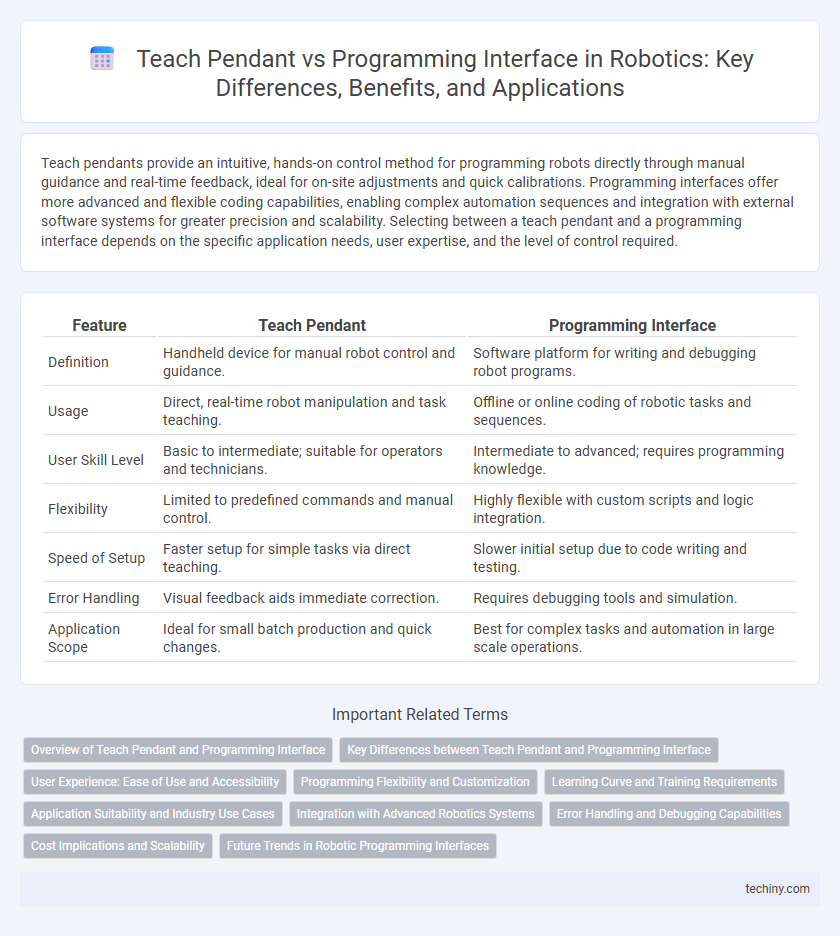Teach pendants provide an intuitive, hands-on control method for programming robots directly through manual guidance and real-time feedback, ideal for on-site adjustments and quick calibrations. Programming interfaces offer more advanced and flexible coding capabilities, enabling complex automation sequences and integration with external software systems for greater precision and scalability. Selecting between a teach pendant and a programming interface depends on the specific application needs, user expertise, and the level of control required.
Table of Comparison
| Feature | Teach Pendant | Programming Interface |
|---|---|---|
| Definition | Handheld device for manual robot control and guidance. | Software platform for writing and debugging robot programs. |
| Usage | Direct, real-time robot manipulation and task teaching. | Offline or online coding of robotic tasks and sequences. |
| User Skill Level | Basic to intermediate; suitable for operators and technicians. | Intermediate to advanced; requires programming knowledge. |
| Flexibility | Limited to predefined commands and manual control. | Highly flexible with custom scripts and logic integration. |
| Speed of Setup | Faster setup for simple tasks via direct teaching. | Slower initial setup due to code writing and testing. |
| Error Handling | Visual feedback aids immediate correction. | Requires debugging tools and simulation. |
| Application Scope | Ideal for small batch production and quick changes. | Best for complex tasks and automation in large scale operations. |
Overview of Teach Pendant and Programming Interface
Teach pendants provide a handheld device with a user-friendly touchscreen and buttons to manually guide and program industrial robots through direct manipulation and intuitive graphical interfaces. Programming interfaces, including IDEs and script-based environments, enable advanced robot programming using code languages such as Python or RAPID, offering precise control and automation capabilities. Both tools play essential roles in robotics, with teach pendants suited for on-site manual teaching and programming interfaces designed for complex algorithm development and simulation.
Key Differences between Teach Pendant and Programming Interface
Teach pendants offer intuitive, handheld control for real-time robot programming and manual guidance, ideal for on-the-spot adjustments. Programming interfaces provide more advanced, code-based environments for developing complex robotic tasks and integrating with broader automation systems. Key differences include ease of use, flexibility, and the level of precision in programming capabilities.
User Experience: Ease of Use and Accessibility
Teach pendants offer an intuitive, hands-on user experience with tactile controls and a graphical interface that simplifies robot programming for operators with minimal coding knowledge. Programming interfaces, often relying on code editors or integrated development environments (IDEs), provide greater flexibility and precision but require advanced programming skills and familiarity with specialized languages. Accessibility is enhanced in teach pendants through mobile, on-site control, while programming interfaces demand desktop setup and can limit real-time adjustments during operation.
Programming Flexibility and Customization
Teach pendants offer limited programming flexibility as they rely on pre-defined functions and manual input, making customization challenging for complex robotic tasks. Programming interfaces provide extensive customization options through scripting languages and APIs, allowing developers to design sophisticated, task-specific behaviors. The ability to integrate with external systems and modify code on-the-fly makes programming interfaces superior for advanced automation requirements.
Learning Curve and Training Requirements
Teach pendants offer an intuitive, device-specific interface that significantly lowers the learning curve for robot operators, requiring minimal programming knowledge and shorter training periods. Programming interfaces demand familiarity with coding languages such as Python or RAPID, which extends the training timeline but enables more complex and customizable robot behaviors. Organizations often choose teach pendants for rapid deployment in production environments, while programming interfaces are favored for advanced automation tasks requiring precision and flexibility.
Application Suitability and Industry Use Cases
Teach pendants offer intuitive manual control and real-time adjustments, making them ideal for on-site robot calibration, maintenance, and fine-tuning in manufacturing environments. Programming interfaces provide advanced coding capabilities suitable for complex automation tasks, integration with enterprise systems, and scalable deployment in industries like automotive and electronics. Industry use cases show teach pendants excel in small-batch production or custom assembly lines, whereas programming interfaces drive efficiency in high-volume, precision-driven processes.
Integration with Advanced Robotics Systems
Teach pendants offer intuitive, manual control for immediate robot path adjustments, whereas programming interfaces provide comprehensive access to robot operating systems for complex task automation. Advanced robotics systems benefit from programming interfaces that integrate seamlessly with AI algorithms, vision systems, and networked sensor arrays to enhance real-time decision-making. This integration enables precise synchronization between robot motion and external devices, optimizing performance in sophisticated manufacturing environments.
Error Handling and Debugging Capabilities
Teach pendants offer intuitive error handling by providing real-time alerts and step-by-step troubleshooting directly on the device, enabling quick corrections during manual robot operation. Programming interfaces feature advanced debugging tools such as breakpoints, variable monitoring, and simulation environments, allowing developers to identify and resolve errors before deployment. Integration of both methods enhances overall system reliability by combining on-the-spot diagnostics with in-depth analysis and refinement.
Cost Implications and Scalability
Teach pendants offer lower upfront costs and are ideal for simple, small-scale robotic applications, but they lack flexibility and become expensive to scale across multiple robots or complex tasks. Programming interfaces, while requiring higher initial investment in software development and skilled personnel, provide greater scalability and cost-effectiveness for large-scale deployments and advanced automation processes. Choosing between teach pendants and programming interfaces involves balancing initial cost constraints against long-term scalability and operational efficiency in robotic systems.
Future Trends in Robotic Programming Interfaces
Future trends in robotic programming interfaces emphasize enhanced user experience through intuitive teach pendants with augmented reality overlays, enabling operators to visualize and manipulate robot paths seamlessly. Advances in AI-driven programming interfaces aim to reduce coding complexity by incorporating natural language processing and machine learning for adaptive task execution. Integration of cloud-based platforms supports collaborative programming and real-time updates, ensuring scalability and improved maintenance in industrial automation.
teach pendant vs programming interface Infographic

 techiny.com
techiny.com